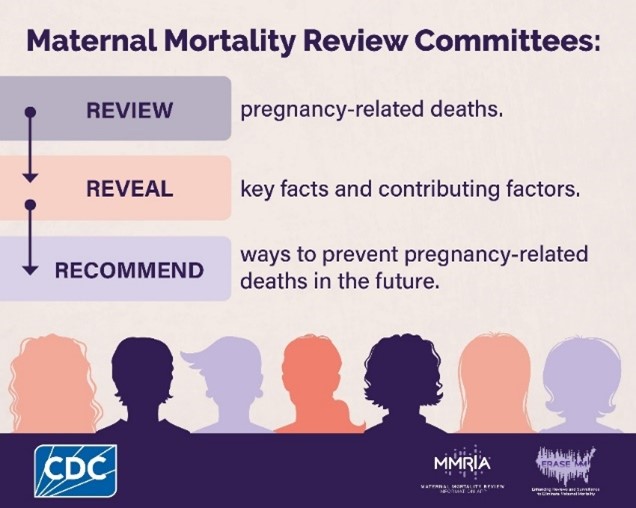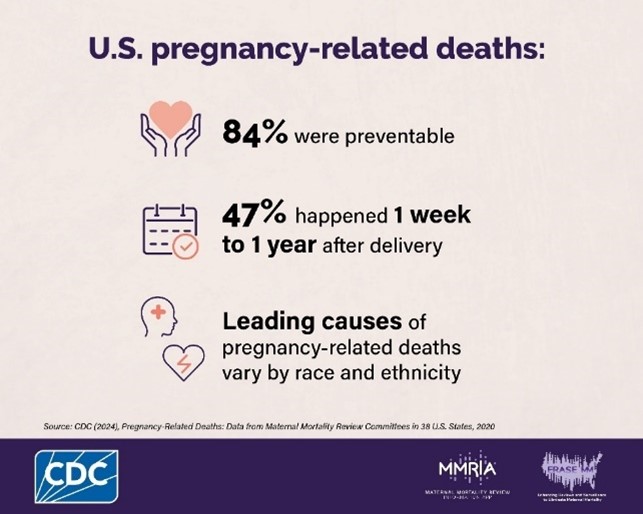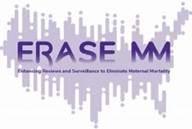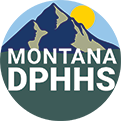Montana Maternal Mortality Review Committee (MMRC)
Background on MMRCs
MMRCs work at the state or local level to identify, review, and understand pregnancy-related deaths. Then, they make recommendations for action backed by data. Through the work of MMRCs, the CDC reports that 84% of U.S. pregnancy-related deaths are preventable. Every pregnancy-related death is tragic, and many are determined to be preventable. (CDC, 2024, Pregnancy-Related Deaths: Data from Maternal Mortality Review Committees in 38 U.S. States, 2020).


The purpose of the Montana MMRC is to identify, review, and characterize pregnancy-related deaths and to identify prevention opportunities. This work 1) helps us understand the drivers of
maternal mortality and pregnancy complications; 2) identifies what interventions at the patient, provider, facility, system, and community levels are most likely to be effective; and 3) guides implementation of these interventions in communities where the need is greatest.
The Montana MMRC was formed in 2021 and is funded through a Centers for Disease Control and Prevention (CDC) grant titled “DP24-0053 Enhancing Reviews and Surveillance to Eliminate Maternal Mortality (ERASE MM).” The Montana MMRC is administered by the Maternal Mortality Review and Prevention program (MMRP) through the Montana Department of Public Health and Human Services (DPHHS), Early Childhood and Family Support Division (ECFSD), Maternal and Child Health Coordination Section, which provides staff support to the committee.

Pregnancy-associated death: A death during or within one year of pregnancy regardless of cause
Pregnancy-related death: A death during pregnancy or within 1 year of the end of pregnancy from a pregnancy complication, a chain of events initiated by pregnancy, or the aggravation of an unrelated condition by the physiologic effects of pregnancy.
Pregnancy-associated, but not related death: A death during or within one year of the end of pregnancy from a cause that is not related to pregnancy.
Preventable death: A death is considered preventable if the committee determines that there was at least some chance it could have been avoided with reasonable changes to patient, family, provider, facility, system, and/or community factors.
The work of the MMRCs uncovers detailed circumstances of each death, using a variety of sources. This separates MMRC data from other maternal mortality data systems, such as the Pregnancy Mortality Surveillance System (PMSS), and the National Vital Statistics System (NVSS). While these systems are important resources, they do not provide enough information to understand the circumstances of each death. MMRCs contribute significantly to maternal mortality data by identifying contributing factors, determining preventability, and identifying recommendations for prevention at local levels. Due to the in-depth review process, “MMRCs are the gold standard for identifying and describing pregnancy-related deaths.” (CDC, About the Information from Maternal Mortality Review Committees, 2024. Publication on data sources.)
Vision:
The Montana MMRC vision is to eliminate preventable pregnancy-related deaths, reduce maternal morbidities, and improve population health for pregnant and postpartum women in Montana.
Mission:
The mission of the Montana MMRC is to identify pregnancy-associated deaths, determine pregnancy-relatedness, identify cause and contributing factors to deaths, and recommend preventions at the individual, provider, facility, system, and community level to reduce these deaths, promote change, and improve systems of care.
Goals:
- Perform a thorough record abstraction to obtain details of events and issues surrounding a death.
- Perform a multidisciplinary review of cases to gain a holistic understanding of the issues.
- Determine the annual number of pregnancy-related deaths (pregnancy-related mortality).
- Identify trends and risk factors among pregnancy-related deaths in Montana.
- Recommend improvements to care at the individual, provider, facility, system, and community levels with the potential for reducing or preventing future events.
- Prioritize findings and recommendations to guide the development of effective preventive measures.
- Recommend actionable strategies for prevention and intervention.
- Disseminate the findings and recommendations to a broad array of individuals and organizations.
- Promote the translation of findings and recommendations into quality improvement actions at all levels.
Cases are identified by: 1) the pregnancy check box on the death certificate, 2) linking maternal death, birth, and fetal death records, and 3) searching for pregnancy diagnosis ICD-10 codes or causes of death that are pregnancy-related. If a case is determined to be associated with a pregnancy, the nurse abstractor gathers additional information by obtaining medical, law enforcement, and social history records. Examples of sources of information may include prenatal care, medical specialty care, autopsy and toxicology reports, and social media. A de-identified case narrative is written by the abstractor summarizing these findings.
The Montana MMRC uses a standardized process to review each case. The committee discusses and votes on these core questions: 1) Was the death pregnancy-related? 2) What was the cause of death? 3) Was the death preventable? 4) What were the contributing factors to the deaths? 5) What are the recommendations that address those contributing factors? 6) What is the anticipated impact of those recommendations? The recommendations are shared with partners to guide future work on improving maternal health in Montana.

The MMRC is a multidisciplinary committee that strives to maintain a 60/40 ratio of clinical/non-clinical members. Required specialties include obstetric and midwifery medical providers, behavioral health providers and specialists, Medicaid representatives, medical examiner or coroner representatives, public health specialists, legal or justice specialists, community-based programs, Tribal health representatives, and individuals with lived experience. Non-required specialties include other representatives of organizations or programs with specialized expertise that would contribute to recommendation development. The CDC recommends best practice as emphasizing inclusion of members representing populations disproportionately affected by maternal mortality. In the state of Montana, American Indians (AI) most represent this population, and membership slots will be dedicated to AI members and AI health organizations, especially as members with lived experience.
Select the links below to download MMRC reports:
MMRC 2020 Data and Recommendations Report
Mental Health and Substance Use Disorder in Maternal Mortality Report, 2020-2022
Thank you for your dedication to supporting the health and well-being of Montana’s families and communities. Applications are now open for MMRC Voting Members for 2026. While we welcome applicants from all fields of expertise, this cycle we will prioritize candidates who are community health workers, Indian Health Service (IHS) representatives, public health nurses, and providers with psychiatry expertise.
Applications submitted by December 19, 2025, including those received since the close of the last cycle, will be reviewed. Priority consideration will be given to the roles listed above and to applicants representing Tribal nations and other communities experiencing higher rates of maternal mortality.
Select the link to apply for the MMRC: Montana DPHHS Maternal Mortality Review Committee Member Application
For additional information, contact:
Carolyn Royal, MPH, RN
Carolyn.Royal@mt.gov
(406) 444-2924

